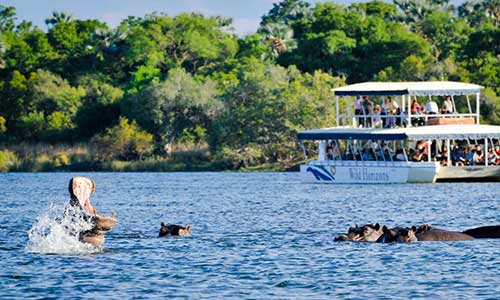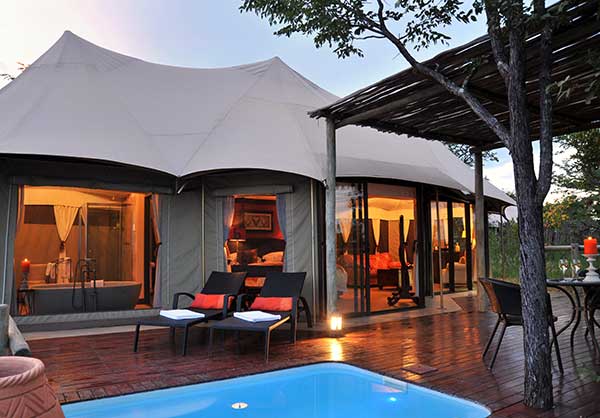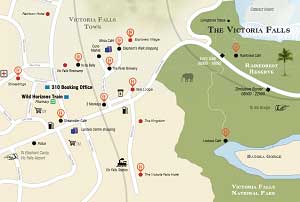Our eco-initiatives and empowerment projects have continued despite the downturn in tourism as a result of the global pandemic. We are excited to share with you, two awards we recently received.
Victoria Falls throughout the year
From the relentless waves of mist that shoot up from the depths of the gorge, to the rugged rock face that breaks through a gentler flow, the Victoria Falls is magnificent in all her forms. Cloaked in chaotic white water or revealing the basalt that has been moulded by the elements over centuries, the raw power of this natural wonder will consume your imagination and leave you humbled and in awe. This is Victoria Falls throughout the year.
January
The height of the rainy season and the Victoria Falls is reaching towards peak flow, with a massive volume of water cascading into the lips of the gorge. You will undoubtedly get drenched and the thick, green vegetation is decorated with bursts of colour as rainforest flowers bloom.

February
The Smoke that Thunders reaches amazing heights during February, joining the clouds that languish above the rainforest. Almost every section of the rainforest is caught in a constant shower of vapour that swells up from the bottom of the gorge.

March
The dramatic rainy season starts to teeter out but the river levels remain high and the Victoria Falls continues to furiously pump the Zambezi into the gorge.

April
It is the end of the rainy season, but catchment areas upstream in the Zambezi continue to nourish the Victoria Falls. The waterfall reaches its highest flow with an average of 500 million liters of water crashing over every minute. The highest ever recorded was 700 million liters in 1958.

May
Autumn settles in, casting golden hues onto the trees. While the leaves slowly fall, Zambezi continues a strong and steady flow despite the advent of the dry season.
June
As autumn gives way to a crisp winter, the water levels begin to drop exposing the grass cover, creating great game viewing opportunities.

July
In the absence of rain, the Mopane leaves take on their distinct winter hue of burnt orange. The waterfall still boasts an impressive flow of water, and due to the diminished water sources in the bush, game viewing is excellent as wildlife begin to congregate around the river and larger water sources. The bush may be dry but the Victoria Falls still creates rain on these cloudless days.

August
A chill creeps into the night, but the days remain warm. Gradually, the rock face emerges as the water trickles to a gentle ebb on the Eastern Cataract on the Zambian side of the waterfall. However, Main Falls maintains an impressive curtain of falling water, and as the mist dies down, photo opportunities within the rainforest are exceptional. As the seasons shift, more elephant migrate to the islands, which are the feeding ground in the drier months.

September
The temperatures start to climb and the days get hotter, but white water rafting is excellent this time of year due to the low water levels, so you can escape the heat and spend the day racing through the gorge on a white water adventure.

October
This is the hottest month of the year as we build up to the rainy season. Occasionally, the sky cracks open with in a torrential African thunderstorm bringing some relief to the landscape in a short, dramatic burst. The Eastern Cataract is usually dry this time of year, but the view of the Victoria Falls from the Zimbabwean side is as beautiful as ever.

November
The water levels are their lowest this time of the year, and while the thunderous roar of the waterfall has been tamed, the natural wonder still inspires a sense of awe and incredulity.

December
The rainy season is approaching, and storm clouds loom ominously over Victoria Falls. The cloud cover brings some respite from the hot and humid days, and the waterfall begins to rise rapidly with rains from catchment areas. By now the Eastern cataract will no longer be exposed and there is a sense of anticipation and excitement as the promise of rainfall rumbles overhead.

Beyond The Challenges, Our Passion & Purpose Prevails
Negative Ions Inspire Positive Vibes | Victoria Falls
When you step into a raw, natural space, something shifts – emotionally, physically and mentally. Your skin tingles as it absorbs sun rays, your mind clears as crisp fresh air blows over you, and your thoughts dissolve to create room for immersive mindfulness. Some places inspire this reaction to a higher degree than others. Places that evoke a sense of empowerment as well as tranquillity, igniting an electrifying paradox of sensations. Anyone who has done a tour of the Victoria Falls rainforest will understand the intoxicating feeling, but not everyone understands what causes this euphoric state. Beyond the joy that comes from being away from stress and in a beautiful place like the Victoria Falls, there is something else at work here – negative ions.
The Ultimate Guide For Your Safari in Victoria Falls
The Ultimate Guide For Your Safari in Victoria Falls The world is stirring back to life, and Africa is calling. It is time to veer off the beaten track - to leave the confines of narrow walkways, to emerge from the clusters of building blocks and detach from...


















